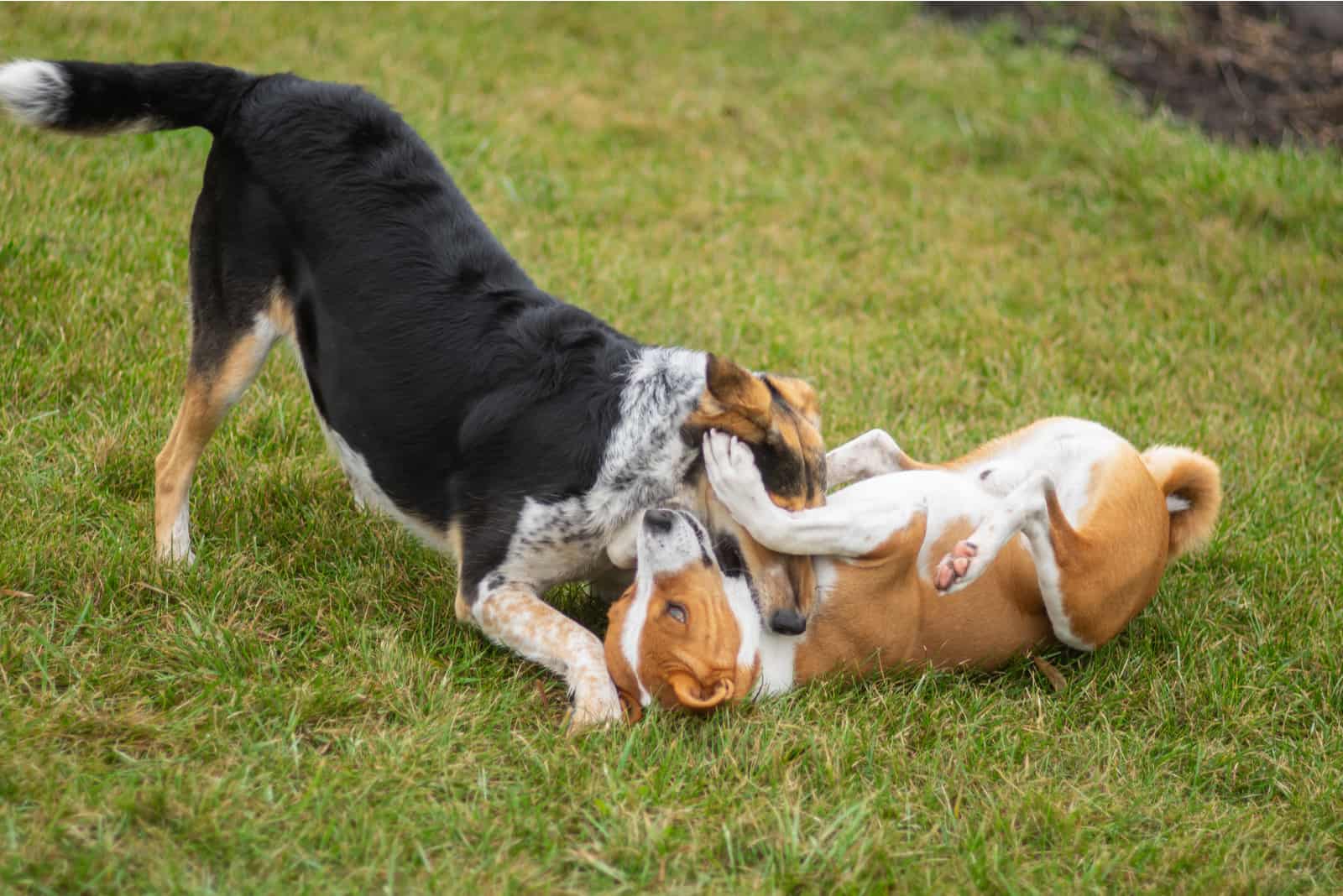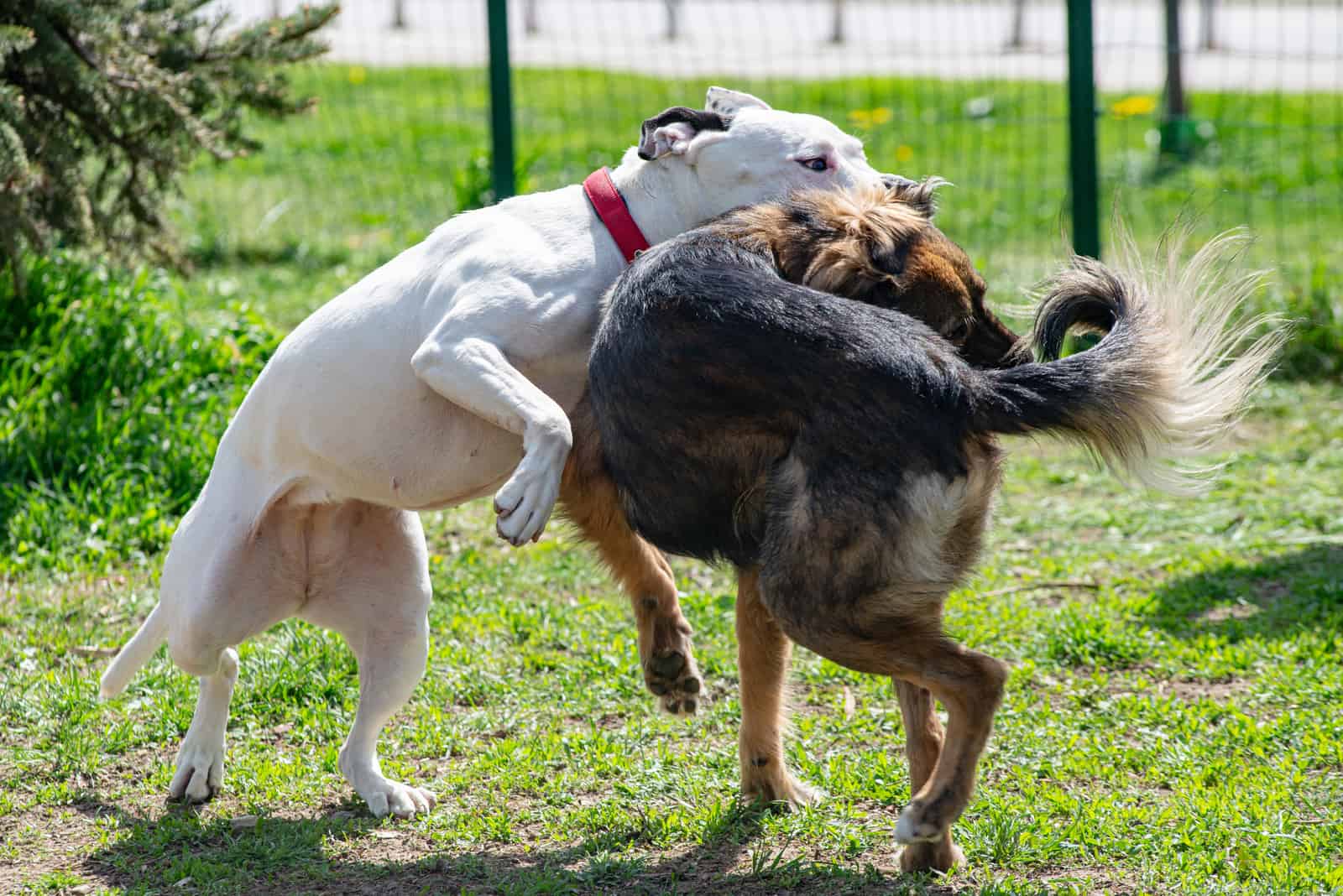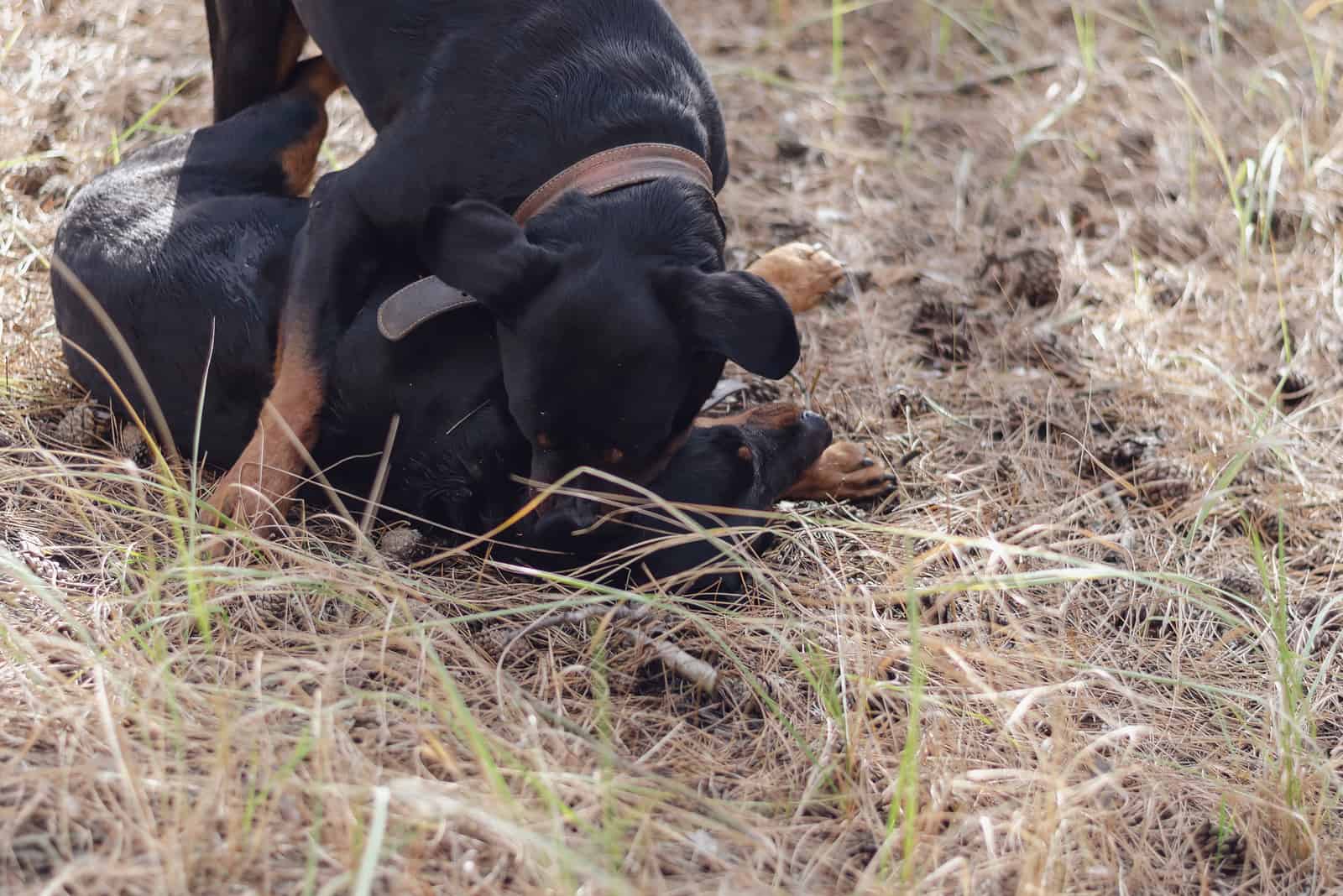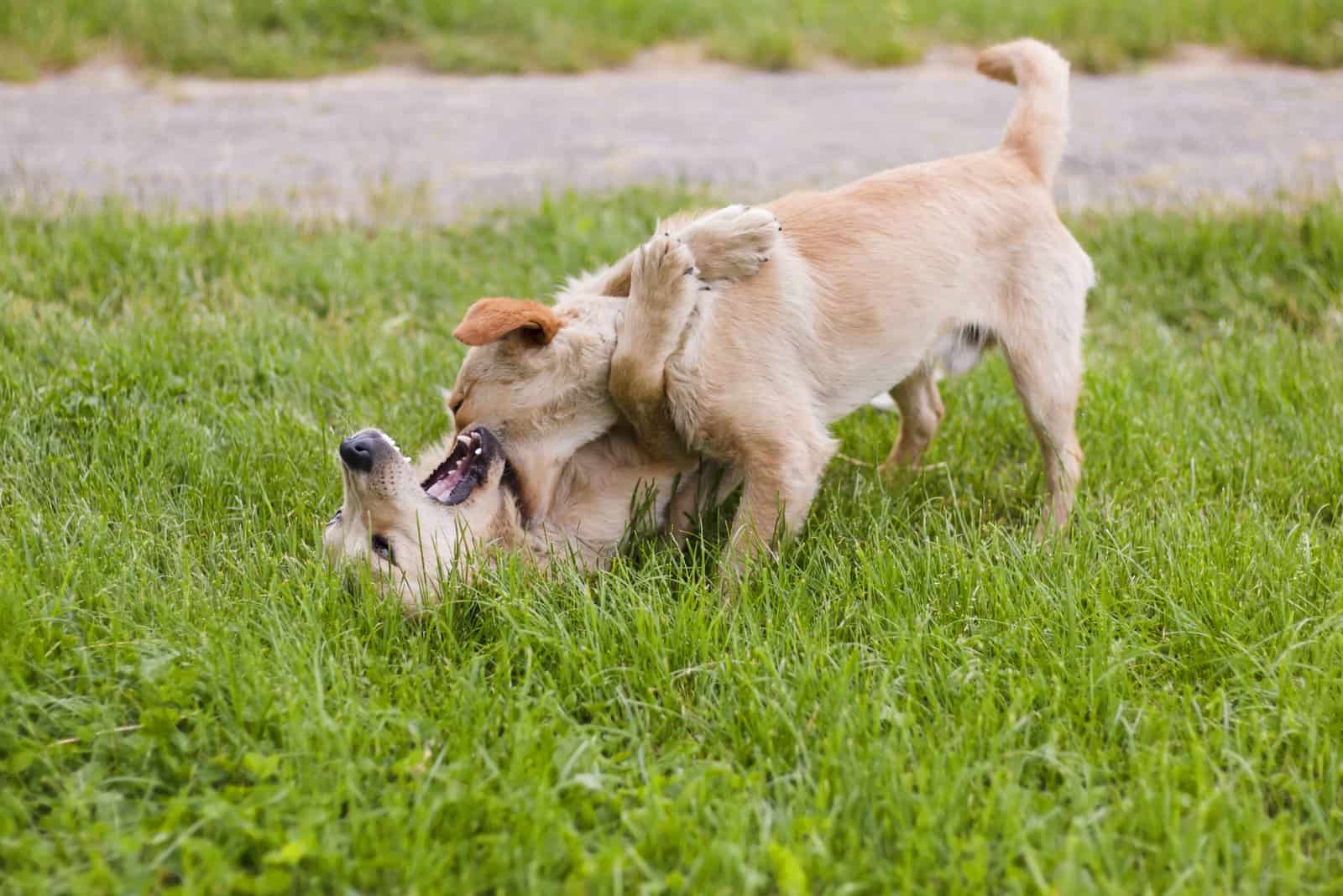Just when you thought that you have figured out your dog’s behavior, it starts acting all goofy — nibbling and biting other dogs necks. What’s up with that?
Whether you’re a concerned dog owner or a curious bystander, you have probably seen dogs playing in the park. You may have noticed some unusual sounds and body gestures during dog playtime — from growling, murmuring, barking, snarling, to neck biting.
Are these signs of play or signs of aggression? Is this situation going to escalate into a serious dog fight? Why do dogs bite each other’s necks? Is there anything you can do about it? Should you do anything about it?
Before answering any of these questions, it’s crucial to understand a dog’s body language. What’s even more important is to stay calm.
Let’s learn more about why do dogs bite each other’s necks and warning signs to look out for.
Why Do Dogs Bite Each Other’s Necks In The First Place?

Dog biting behavior isn’t necessarily a negative nor a dangerous thing. It can be if the dog hasn’t gone through early socialization and training.
Play biting and nibbling is in your dog’s nature. It’s simply how your little fur baby is programmed. Such dog behavior is instinctual. It can be modified with regular training, but it can never be rooted out.
Is it normal for puppies to bite each other’s necks?
It’s more often that we see dogs nibbling on each other and playfully biting on dogs’ faces. Neck biting in dogs is a bit more specific.
Mother Dog Carrying Her Puppies
This is something we see in dog maternal behavior. It’s completely normal for a mother dog to carry her puppies from one place to another.
The only way she can do this is by gently biting her puppy by the scruff and lifting it up. This is by no means dangerous behavior, nor does it inflict pain on the youngsters.
Besides carrying puppies, mother dogs have another important role in puppy development that includes biting. After weaning her puppies, the mother dog starts to teach them about doggie manners.
For example, when puppies are learning to eat solid food, some may show food aggression. But, greediness is a no go. So, the mother growls and bites the puppy’s ear, neck, or muzzle.
This is only a warning sign and a way to scold them. A good mother dog does not harm her pups.
Puppy Playtime And Bite Inhibition
Newborn puppies have no idea what’s going on around them. In order to learn about the world they have found themselves in, they decide to taste it, literally.
Before they learn to bark, and even before their baby teeth start emerging, puppies start nibbling on both littermates, mother dogs, and inanimate objects. That’s their way of getting by.
When a puppy is interacting with its littermates, it is communicating through scent, biting, yelping, and barking.
Sibling rivalry in puppies is noticed from the very first moments of their lives. Biting is what plays the most important role here.
Through puppy play biting, the little one learns about its boundaries —- how much is too much. Its sibling will most likely yelp if the bite is too hard, showing it that it should let go. This is how a young puppy learns a thing or two about bite inhibition, a useful social skill taught between ten weeks to five months of age.
Bite inhibition in puppies is a socially learned behavior. Playmates test their bite strength on each other during playtime in which they learn when to stop. In other words, they learn not to use their full strength when biting.
Puppies who fail to learn bite inhibition are most likely to inflict wounds on both people and other animals.
Aggressive Behavior Or Play Fighting?

When it comes to play biting, both experienced and inexperienced pet owners know that there is a thin line between aggressive behavior and play behavior. Dogs like to play rough, so it’s no wonder most dog owners get confused between these two types of behavior.
The most important part is how to tell the difference between aggressive behavior and play fighting.
In order to distinguish aggressive behavior from play fighting, we have to start from the most subtle dog body language signs.
You may have not thought about it, but a dog’s neck is a very sensitive part of the body. The dog’s neck is where vital blood vessels (such as the jugular vein) are located. Moreover, trachea, esophagus, lymphatic nodes, and spinal cord are mostly what the inside of a dog’s neck consists of.
Minor damage to any of these vital body parts would result in serious (and even irreversible!) health conditions.
Due to this delicate body area and the fact that dog neck biting is a specific form of behavior, I find it necessary to firstly talk about the warning signs you should look out for.
Dog Neck Biting: Aggressive Behavior
Recognizing aggressive behavior in dogs during playtime is crucial — especially for new dog owners. In a matter of seconds, silly playtime can turn into a dangerous dog fight.
In almost all cases, there will always be that one dog among the pack that displays dominant behavior. Sometimes, the dominant dog will bully other dogs. There are also times when a submissive dog finally stands up for itself, but reacts in an aggressive manner.
Therefore, noticing early warning signs that show aggressive tendencies will help to take action and prevent a dog fight from escalating.
In case a dog fight does break out, you should never put yourself in the middle of it. Putting yourself in the middle of a dog fight increases your risk of getting seriously bitten. It’s best to distract the dogs, separate them physically, or by using an object between them.
Let’s describe some worrying warning signs of aggressive behavior in dogs.
Raised Hackles
Hackles are tiny hairs along the dog’s spine. They sit on top of its coat, forming a dense hairline.
When I’m explaining to someone what hackles are, I like to compare dogs to cats. When cats get scared or angry, they get all puffed up and fuzzy. They raise their little spines to appear bigger, as their body hair erects.
It’s the same with dogs, except that they do not position their body like cats do, nor their whole coat puffs up.
The hackles along its back move upwards when the dog is in a “flight or fight” position. In other words, erect hackles are a sign that your dog is excited — but not in a good way.
Hackles are raised when a dog is either stressed out, scared, or ready to attack. Following raised hackles is the dog’s tail that can be positioned either stiffly upwards or tucked under its hind limbs.
Low Growling
Low growling sounds as if your dog is murmuring. Its mouth is barely open and its teeth are not showing. However, it is showing subtle signs that something is not right. The low growl itself should not be the only behavior sign observed. We have to look at the bigger picture.
The dog’s body position and demeanor change as it is growling. Its ears are pulled backwards and its tail is usually pointed upwards. Eyes are wide open and the dog is ready to defend itself or quickly run away.
Low growling during playtime is normal to a certain degree. It usually occurs when dogs are biting each other’s necks, ears, muzzles, etc. Such growls are not prolonged, but short and silly.
Your dog may growl at nothing, for no particular reason. It may also growl to show affection towards you or its playmate.
Deep Growling
When low growling turns into deep growling, the dog clearly does not want to play around anymore. Deep growling and snarling usually go together and they are followed by a group of body language signs.
Alongside deep growling, your dog takes a very protective stand. Its legs are stiff and eyes pointed at its threat. Its upper lip is curled while its teeth and gums are showing. This is almost never a sign of good dog behavior.
Deep growling in dogs is associated with protecting one’s territory and standing its guard. So, if you have two dogs of the same gender, they might show these signs during playtime.
Both low and deep growling during playtime do not necessarily mean danger. Most of the time it’s a way of letting out the excess energy and communicating. You will easily distinguish playful growling from dangerous growling.
Growling in dogs is generally more of a negative behavior than it is positive. However, some dogs growl when they’re happy.
Lunging Towards Another Dog
If you’re keeping your dog on a leash (as you should), and it starts lunging towards another dog, you should definitely leave playtime out of option. Specifically if it’s an unknown dog your pup is lunging towards.
Pet owners cannot be 100% sure what a lunging dog’s intent is. In this case, it’s best to keep both dogs at a safe distance, until they calm down. Next thing to do is let them sniff each other. If one of them is barking and still behaving badly, it’s best to leave the getting-to-know games for the next time.
Lunging is usually followed by growling and snarling. These are obvious signs of aggressive behavior in dogs.
Dog Grabbing Other Dogs Neck And Shaking
This is something you definitely do not want happening. Out of all aggressive dog behaviors, I would say that this one is the most dangerous one. And here’s why.
Even though they are domesticated and live in our houses, some dog breeds still have strong hunting instincts.That being said, they inherit a strong prey drive, which means that they chase and hunt down small prey.
Once they get their teeth on their prey, dogs take it by the neck and do a quick, but firm shake. This lethal movement cuts the prey’s spinal cord, leaving it dead. I’m honestly not sure how dogs figured this out, but it is how it is.
Now, it is considered aggressive neck biting when it happens between two dogs. And oh boy, can this be dangerous.
If a dog gets ahold of another dog’s neck, it starts violently shaking its head left and right. This movement, along with a firm bite, causes extreme damage to skin and muscle tissue. In severe cases, it can lead to trachea and esophagus rupture, or even cutting of the spinal cord.
It’s very dangerous when a larger dog bites a smaller dog by its neck. If this isn’t prevented or stopped on time, chances are that the bitten dog will succumb to its injuries.
As we mentioned, some dog breeds are more prone to this type of behavior. For example, high-energy hunting dog breeds like Terriers and Dachshunds might show aggressive behavior towards other dogs. But, let’s not generalize because it all depends on the upbringing and dog training. In the end it doesn’t really matter what breed the dog is.
Older Dog Biting Puppy Neck
If an older dog is familiar with the puppy, playful neck biting isn’t considered an issue. Even scolding the puppy and biting it softly isn’t considered as aggressive behavior. Educating puppies through biting is a normal behavior in dogs.
However, if you’re taking your pup out for a walk and it starts playing with an older dog, it’s best to keep your eye on both of them — especially if you notice that the older dog is biting the puppy by its neck.
An older dog will be bigger than your puppy, so even if they are playmates, the older dog may inflict minor to major injuries to the pup.
Keep in mind what you have read just above this paragraph. Some dogs might see puppies as small prey. This is where neck biting is unacceptable.
Dog Neck Biting: Play Fighting
Is it normal for dogs to bite each other’s necks while playing?
Yes! It is definitely normal. In fact, it would be abnormal if a dog didn’t bite its mate during playtime.
We stated some bad dog behavior signs that may appear when dogs play, it’s time to show you how a good boy behaves!
Play bow
Play bow is when a dog lifts its bum up while holding both forelimbs on the ground. This type of behavior is an invitation to fun playtime. Most dogs will want to play catch when you try to approach them.
Its tail wagging, ears are pointed upwards, and it seems as if it’s smiling! Such a good boy!
Sometimes, a dog might bark at nothing. Although this behavior might come off as odd to some dog owners, it’s perfectly normal. A dog barking at nothing usually doesn’t pose a threat to others.
Play bow happens in between play biting sessions, and there is nothing aggressive about it. A dog is literally telling another to come and play!
Hugging And Jumping
When puppies get the zoomies, they are all over the place! They often jump on one another which can appear as if they are giving each other a hug.
Both dogs are standing on their hind legs while their front legs are intertwined. This is usually followed by playful growling and neck biting.
It might appear as if they are fighting, but in reality, this is a very friendly dog behavior. Nothing to worry about!
When Should I Be Concerned About My Dog Biting Another Dog’s Neck?

A call for concern is when you notice that the dog play is getting out of paw. In case you notice any of the warning signs that we have mentioned in this article, it’s best to separate the dogs for a while.
Low and deep growling, lunging, snarling, and barking at other dogs are usually signs of aggression, which is often the result of inadequate socialization. If you notice that a dog is holding the other’s neck for some time, you should act quickly and separate the two.
If a dog shows any signs of aggression, you should carefully move it away from the situation he is in. From your side, avoid showing excitement and frustration.
Arm yourself with a cool head and strong will. Dogs can sense energy and emotions, so if they find out you’re agitated or excited, it will be difficult to calm them down.
What Should I Do If My Dog Is Biting My Other Dog’s Neck?
Sit. Watch. Observe.
If you notice that your dog is biting your other dog’s neck, don’t rush to separate them yet. Instead, sit down and observe their body language. Neck biting is normal during dog’s playtime, so there is no need to interfere every time you see it happening.
Quality playtime is a good sign. It shows that both dogs learned bite inhibition and that they know how to play. If both of your dogs are well socialized, they will work out any dilemmas between themselves.
Simply, if the playtime gets too rough, your other dog will let the “attacker” know it’s enough by growling, yelping or biting back once or twice. These actions act as warning signs and are usually harmless.
How Do I Stop My Dog From Attacking My Other Dog’s Neck?
If rough playtime gets out of control and you notice continuous biting that is followed by loud yelping and deep growling, it’s time to do something about it.
Try distracting your dogs with a ball or their favorite plush toys. Do not distract them with food as you will be rewarding bad behavior.
Do not stand between them as there is a chance of you getting bit.
Include positive reinforcement dog training, remove anything that might trigger your dog’s aggressive behavior, socialize your dog, practice regular obedience training, and include daily mental activities to keep your dog busy.
What Should I Do If My Puppy Bites Me?
Puppy teething period starts when their first baby teeth emerge (around three weeks of age). However, the most annoying teething period for both the puppy and you is between five and eight months of age.
Why are we mentioning this? Because it’s completely normal for your puppy to nibble on you during its mouthing period.
If your puppy learned bite inhibition, its bite shouldn’t be painful. It will know that it’s doing a bad thing and that it should stop.
However, if your puppy won’t stop biting you, it’s best to take some extra steps in dog training. Don’t break your head over this puppy behavior.
Your puppy will grow out of its mouthing and biting phase as soon as it reaches nine months of age. In some cases, puppies stop biting when they are one year old.
On the other hand, if an adult dog bites you, this calls for immediate action. Try to figure out the reason behind its bite. If there’s a clear reason, start working on fixing the root of the problem.
Socializing an aggressive dog takes a lot of time, knowledge, and patience. For first-time dog owners who are unsure how to handle a reactive or aggressive dog, it’s best to seek professional dog trainer help.
Final Thoughts
Oh, if only dogs could talk! Imagine how many new and interesting things we would find out. For instance, the first thing I would ask a dog is “Why do dogs bite each other’s necks?” Like, why do you guys do this?
Our dogs are showing many body language signs that we have to pay attention to. It doesn’t always need to be vocalized. Dog’s tail positions, ear positions, as well as its whole body posture tells us a lot about its feelings and intentions.
Playful neck biting is a perfectly normal dog behavior that mostly all dogs experience. There is usually no need to worry, unless a dog shows signs of aggressive behavior.
Luckily, you can now understand dog neck biting behavior better, as well as distinguish play fighting from aggression.
Next thing to do is go to a nearby dog park and observe different types of dog behavior!
Related Content
• Why Do Dogs Rub Their Face? Find Out 11 Possible Reasons!
• Why Do Dogs Sleep With Their Bum Facing You? 10 Reasons Why
• Why Does My Dog Stare Into Space: 9 Reasons For Blank Stares
